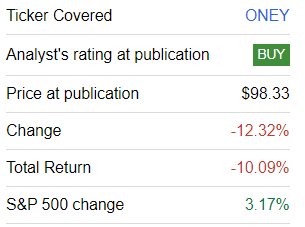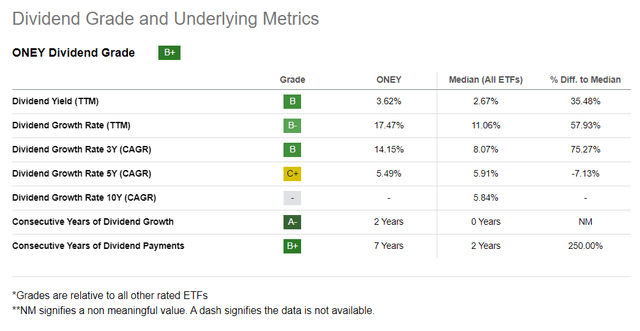The SPDR® Russell 1000® Yield Focus ETF (NYSEARCA:ONEY) had surprised to the upside since my first note published in June 2021, which I have discussed in January this year. Alas, the issue is that ONEY has not lived up to expectations this time.
And even though the fund had a strong run until February 2, rising by more than 4%, it has given up all the gains later amid the bank drama in the spring. As a consequence, it has underperformed the S&P 500 index, even though the latter has also been under pressure recently and is now technically in correction territory.
Seeking Alpha. Screenshot taken October 28, Eastern Time
In this regard, the purpose of today’s article is to address the following points:
- What stocks were the main detractors from ONEY’s return?
- How has the portfolio changed since January?
- Is the factor mix still supportive of a Buy rating?
What is ONEY’s investment mandate?
In short, since its inception in December 2015, ONEY has been managed passively, with the Russell 1000 Yield Focused Factor Index being the basis of its strategy. A brief benchmark description on the fund’s website says that this index
… is designed to reflect the performance of a segment of large-capitalization U.S. equity securities demonstrating a combination of core factors (high value, high quality, and low size characteristics), with a focus factor comprising high yield characteristics (the “Factor Characteristics”). To construct the Index, Frank Russell Company (“Index Provider”) utilizes a proprietary rules-based multi-factor scoring process that seeks to increase exposure (or “tilt”) to companies in the Russell 1000 Index demonstrating the Factor Characteristics.
ONEY has replaced ~25% of the portfolio since January: the implications
Comparing the datasets as of January 13 and October 24, I noticed that ONEY has replaced more than a quarter of its holdings. For example, while Gilead Sciences (GILD), Cummins (CMI), and DuPont de Nemours (DD) were removed, Pioneer Natural Resources (PXD), Devon Energy (DVN), and Diamondback Energy (FANG) were added. The annual rebalancing of the Russell index is the likely reason. Certainly, such a remarkable reshuffle, together with capital appreciation or depreciation of its holdings, has resulted in shifts in factor exposure, which are addressed below.
Valuation and quality
Let us start with value and quality. Here, ONEY still has a lot to offer.
- For example, the fund’s weighted-average earnings yield stood at ~8.3% as of October 25, unchanged from January, as per my calculations. For a fund with a WA market cap of $19.5 billion, this is an attractive level. It is also 1.7x higher than the EY of the iShares Russell 1000 ETF (IWB).
- Price/Sales is modest at 1.93x.
- Importantly, 44% of the holdings have a B- Quant Valuation grade or higher.
- Regarding quality, 85.4% have a B- Quant Profitability rating or higher.
- Less than 6% did not deliver LTM net profit, while only 2% did not report positive EBITDA. There is a similarly small number of cash flow-negative names, just 2.4%.
- Portfolio-wise, capital efficiency is robust, as indicated by a 21% Return on Equity.
- However, six holdings have ROE above 100%, mostly because they have triple- or four-digit Debt/Equity. With these metrics reduced to zero for modeling purposes, the weighted-average figure would drop to 16.2%, which is still fine.
- A minor disappointment is Return on Assets of 6.88%; I would prefer a stronger level.
Considerations on the growth front
The flipside of healthy value characteristics is lackluster growth. For example, the fund has a weighted-average forward EPS growth rate of just 3%, as per my analysis. The primary reason is that EPS contraction is forecast for 43.4% of the holdings. This is not necessarily the consequence of higher interest rates that increase interest expenses and eat into the EPS, as a similar problem is observed with EBITDA, with the decline anticipated for around 30% of the stocks, chiefly from the materials and consumer discretionary sectors. Revenue growth is also rather subdued, as the 4.2% weighted-average rate illustrates; here, the issue is that 28% of the companies are anticipated to report lower sales going forward, according to pundits’ estimates.
Are dividend credentials still attractive?
ONEY’s exposure to solid dividend stories has improved. For example, while its weighted-average dividend yield has risen due to soft performance, both the 3-year and 5-year WA dividend CAGRs have also climbed higher, now in double-digit territory.
| Metric | DY | Div Growth 3Y | Div Growth 5Y |
| October | 4.01% | 11.30% | 10.65% |
| January | 3.29% | 8.16% | 8.25% |
Calculated using data from Seeking Alpha and the fund
The key contributors to the yield are real estate, financial, and materials companies, including Highwoods Properties (HIW), Ardagh Metal Packaging (AMBP), and Annaly Capital Management (NLY).
Besides, ONEY still scores nicely against Quant Dividend grades. For example, 65% of the companies have no less than a B- Safety rating. About 54% sport similar Growth grades.
The fund itself has a remarkable 14.15% 3-year dividend CAGR, though the 5-year figure is much weaker.
Seeking Alpha
However, the yield of 3.6% might also look too small for investors seeking income stories.
Why has ONEY declined so steeply?
Attribution analysis is much more challenging when it comes to portfolios with a turnover of 33%. So today, I would like to analyze only components that were present both in the January and October versions (approximately 79.3%) since I have not been monitoring the portfolio composition since January. For that purpose, I compared prices as of January 16 and October 25 and arrived at the following conclusions:
- Over that period, just 43 holdings out of 224 managed to deliver a positive price return, ranging from just a few bps to a respectable 33% in the case of Allison Transmission Holdings (ALSN).
- It is tough to say precisely what sector has contributed most to underperformance. Nevertheless, I still should mention that among the 181 companies that saw their share prices shrinking over that period, there were 41 financial, 29 consumer discretionary, and 27 real estate names.
- Also, the group of those with losses deeper than 30% is dominated by financials and consumer discretionary, like First Horizon (FHN) and Macy’s (M).
- Surprisingly, not all energy holdings were in the green. In fact, only three names out of eight delivered gains, namely Marathon Petroleum (MPC), Phillips 66 (PSX), and Antero Midstream (AM).
Final thoughts
ONEY is an index-based fund focusing on U.S. dividend names with solid quality and meaningful yields. In the current version, the fund is heavy in financial (16.8%), energy (13.9%), and industrial (10.3%) companies. It has sizable exposure to small- and mid-cap stocks, about 32.6%.
With the S&P 500 index now in correction territory, as the market interpreted the GDP growth surprise as a sign of higher interest rates for longer, optimists may point out that all the risks related to tighter credit conditions, geopolitics, supply chain concerns, etc., have already been priced in. I doubt that. Though not a permabear, I would advocate against reducing exposure to the value factor and cranking up bets on growth at this juncture. In this regard, ONEY, which has comparatively large exposure to value and robust quality, is one of the vehicles I remain bullish on.
However, there are disadvantages. For instance, the fund has almost no exposure to the growth factor, with portfolio-wise rates in single digits and a meaningful presence of companies that will have to address either sales or earnings decline or both. Next, about 22% of its portfolio is overvalued, as indicated by a Quant Valuation grade of D+ or lower; even though this share is comparatively small, it still poses risks in case stock prices continue drifting lower amid interest rate concerns. Also, a distribution yield of 3.6% might look too small for investors who have a goal to maximize income.
Read the full article here



